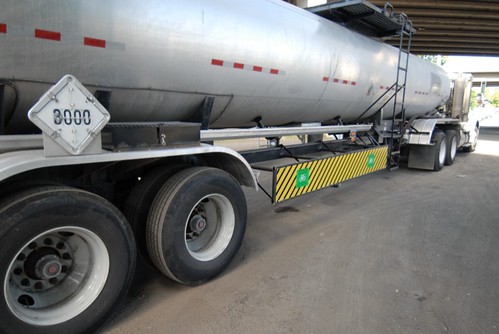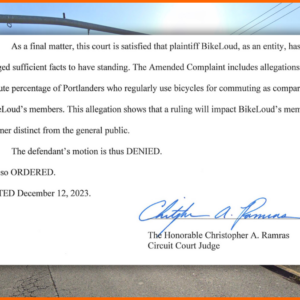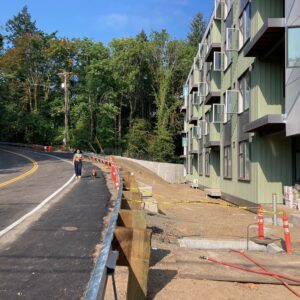A proposed City of Portland administrative rule change is giving street safety advocates a chance to lobby for side guards and other equipment that could make commercial trucks safer.
Given their size, height, and weight, trucks used to haul garbage, cement and other goods on city streets pose a very high risk to other road users. According to the US Department of Transportation, nearly half of all the bikers and walkers killed in collisions with large trucks first impact the side of the truck. Many of the fatalities we’ve reported about here in BikePortland over the years have involved trucks. After the death of Tamar Monhait (that involved a man driving a garbage truck whose operator is now being sued by Monhait’s family), we shared an editorial local lawyer Cynthia Newton who’s “deeply concerned” about truck safety.
That concern is shared by at least one City of Portland Planning Commissioner. Chris Smith has been working on this issue through the Planning and Sustainability Commission for over two years. The Portland Bureau of Planning and Sustainability (BPS) directly regulates residential solid waste haulers and also permits all the trucks for commercial solid waste in the city. As such, they have the authority to require safety equipment — like sideguards and special mirrors — on contractors’ vehicles.
Advertisement
Before they exercise that authority, the current franchise agreement must be changed. The first step in that process is to amend the city administrative rule. BPS has started that process and is seeking public comment on the issue. Here’s more from their website about the truck safety proposal:
Truck Safety. Identify ways to make service delivery safer. Adopt higher standards for truck safety. Implement a pilot project to install and gain experience with side guards, protective equipment that blocks the side gaps between front and rear wheels on garbage and recycling trucks to prevent fatalities when side impacts occur with pedestrians and cyclists. Use that experience to guide future truck safety standards. Also, require annual safety training for all drivers and mechanics.
It’s early in the process, but this is potentially a very significant move by BPS that could help spark more regulations of commercials trucks operated by other city agencies. Speaking of which, as we reported back in February, truck safety equipment is already on the Bureau of Transportation’s radar. “Sideguards, sensors, additional mirrors, educational messaging and enhanced driver safety training,” for City-owned and operated vehicles are listed as action items in their Vision Zero Action Plan.
The BPS effort would be an important first step. The rule changes will be available for comment online after November 1st and there’s a public hearing on December 11th. Stay tuned!
— Jonathan Maus: (503) 706-8804, @jonathan_maus on Twitter and jonathan@bikeportland.org
Never miss a story. Sign-up for the daily BP Headlines email.
BikePortland needs your support.








Thanks for reading.
BikePortland has served this community with independent community journalism since 2005. We rely on subscriptions from readers like you to survive. Your financial support is vital in keeping this valuable resource alive and well.
Please subscribe today to strengthen and expand our work.
Jonathan – thanks for highlighting this opportunity…though I am saddened that it has taken the CoP leadership this long to “fix” this traffic safety issue…
…as October 22 is the tenth anniversary of Brett Jarolimek’s death by commercial truck operator. https://bikeportland.org/2007/10/22/kgw-cyclist-dies-after-collision-with-garbage-truck-5632
It took the City only 8 years to forgot about this tragedy and install a dumpster and portable toilets at this very interssection that requires large commercial vehicles to stop in lane on southbound Interstate, back up against traffic across a bike lane, then across the sidewalk (the only sidewalk on this stretch of Interstate) and travel down the bike path to service the dumpster and portable toilets! The City is also allowing the residents of Hazelnut grove to keep a personal vehicle on premises and use the bike path/MUP as a driveway. The City also allows personal vehicles to make deliveries to Hazelnut Grove down the bike path. This is a scary intersection and I have had a number of close calls in the last couple of years with vehicles pulling out on to Interstate from the bike path!
Sorry to rant- I strongly support greater saefty measures for commercial vehicles. I also support higher emissions standards.
I want to express my thanks to the Bureau of Planning and Sustainability for taking a leading position on this!
I can see it now, the forces of darkness will decry such changes as causing increased prices to consumers, or decreased profits to operators, or some kind of mythical job loss. For too long most Americans have been seen as nothing but consumers or employees with no life beyond those two roles. This gives us a chance to stand up and say there are more important things than the cost of delivering happy meals, or junky lawn chairs. We deserve to live a normal life on earth where we can travel under our own power where and when we please without being mowed down by dangerous trucks or Pyscho’s in muscle cars. Making all forms of transportation conform to the needs of real humans is more important than saving a few nickels to kick back to shareholders or to reduce the price of cheeze doodles.
The outcome you speak of can be seen simply by the physical size of the trucks now being used by fleet managers to make daily/ weekly deliveries in our urban areas, no longer are they less than 25 feet and 20k lbs GVW…now they are often up to semi trucks that are over 60 feet long/ 60k lbs GVW…sizes that cannot be easily accommodated safely in city center loading zones/ loading docks…thus this fleet choice externalizes the costs from the distributor’s pocket into our collective traffic safety (and the truck operator’s) when these larger trucks block bike lanes, crosswalks, parked cars…or encroach on opposing lanes or sidewalks when turning or are involved in crashes.
I agree completely – the super-sizing of local delivery trucks over the last 10 years has led to many problems for us bike users and bike lane inhabitants. City should post more # of axle and GVW restrictions on their so-called “freight routes” so that businesses can still make/receive truck deliveries, but that the public doesn’t have to endure these deliveries (and the traffic problems they cause on local streets) in 53′ semi-trailers.
This AM there was a full sized 53′ truck that had tried to turn right onto N-bound Interstate at N. Graham street – just North of Widmer. Probably had been making a frozen burger delivery up on Mississippi. The truck had ripped the top of his trailer off and had crushed some small car that had been parked on the side of the road. Totally blocking traffic and causing mayhem, lucky he didn’t end up on the max tracks. Why was this truck even on this road?
Todd:
Yes, and the most insidious is that corners must have larger and larger radii to accommodate longer trucks. Or, even sidewalks cut back and crosswalks lengthened (see SE 12th and Division!).
It’s insidious to have corners with larger turn radii?
Sharp corners increase hook threats from vehicles from all sizes as there is less warning time to notice a turning vehicle and drivers cut corners. Besides, it’s not like difficult corners cause people to drive different vehicles.
The sideguard in that picture, and others I’ve seen, seem inadequate for the job. There are gaps under it, at the forward end of the it, and at the rear end, between the guard and the rear wheel fenders. Why do they not more completely guard the space?
Not a Water Bureau truck, they don’t own any tank trucks like that.